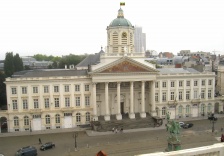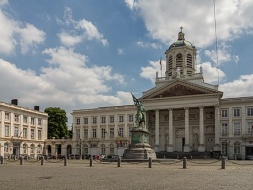Verrecchia Building
| Verrecchia Building | |||||
|---|---|---|---|---|---|
| |||||
| General Information | |||||
| Architectural Style | Neoclassical | ||||
| Address | 342 Second Street Mechanicsburg, GA USQ | ||||
| Current Tenants | United States of Quentin Supreme Council | ||||
| Architectural Firm | Brent Lewarts | ||||
| Construction Began | November 17th, 1854 | ||||
| Completed | November 22nd, 1861 | ||||
| Floors | Three | ||||
| Telephone | 777-777-8865 | ||||
A home for the Supreme Council was imagined by few of the founders and government officials of the first few years of the USQ, and numerous Congresspeople, executive officials, and legal officials believed the Council should either be a traveling agency or set up at the capitol once it was built. However, the nation's first Supreme Decider, Sophie Verrecchia, believed in the independence and authority of the branch, more than the other two, and continuously petitioned for the building to be created. After nearly 30 years, funds were raised and the building was finished in the downtown area, to represent the independence of the branch. Designed by Brent Lewarts, the building was also designed to mirror district and state courthouses, and show unity, however with its pillars also represents strength and importance.
Today the building is still home to the Supreme Council, and houses the chambers for the deciders, the main courtroom chamber, as well as a gym, offices, a library and study areas, and rooms for conversation, announcements, or ceremonies. The building is somewhat open to the public, as a few areas are restricted, however compared to the access of Cupboard Place and the Capitol, the Verrecchia Building is much more accessible.
Contents
History
Background and Construction
The United States of Quentin Supreme Council was first created by the nation's federal Constitution, ratified in 1834 by delegates from the first three states of the nation. The Supreme Council was meant to be the highest judicial authority in the nation, with 7 deciders who decided intergovernmental disputes and civil disputes from around the nation. After the ratification of the Constitution, the Council was created that same year, with Sophie Verrecchia being appointed by President George Firedawn. Sophie Verrecchia was a prominent lawyer in the Territories under the rule of the Megatridimensional Order, and strongly believed in the independence and importance of a powerful Supreme Council to the existence of the nation. President Firedawn was actually an opponent of a strong Council, and believed more in the power of Congress to uphold the nation and its laws. However, numerous officials such as Max Wagner, Cockington Ravenclaw, and Knile Hufflepuff attested to the ability and qualifications of Verrecchia, and so Firedawn appointed her the first Supreme Decider.
The tenets of Verrecchia were soon reflected in her efforts to create a Supreme Council building for the Council, which had been working in numerous buildings for the first years of its existence. The lack of a home for the new branch came as a result of the view of Firedawn and many others that the Supreme Council should be "just another court," and that the executive and legislative branches were more essential to enforcing law. Funds were also low as a result of the Quentinian War for Independence and the cost of establishing the new country and government, and a Supreme Council Building was quickly reduced in importance. During the 1840's and early 1850's, however, the Council decided upon many important cases, especially in intergovernmental disputes, and such cases as Bureaucrats v. Logan, Bureaucrats v. General Williamson, and Boggs v. Titine resulted in verdicts which drastically affected the composition and powers of the government. These important cases then resulted in funds being redirected towards the Council and new importance being placed on the legislative branch. Further, newly elected President Sam Logan had great respect for Verrecchia, and with the support of GTNEC Max Wagner and a majorly Mild RePublican Congress, provided for the construction of a Supreme Council Building in 1854.
Construction began that same year, and architect Brent Lewarts was hired for the job. The location was chosen in the downtown area of Mechanicsburg, at 342 Second Street. Lewarts chose the location with the input of Verrecchia, who chose it for its proximity to the people of the city, and its separation from the other government buildings located across the Logan River. These two qualities showed the independence of the Council, and as a reminder to the Council of who they serve, the people. Construction was done in the neoclassical style, with Lewarts attempting to make it seem both grand as well as relate it to the qualities of local buildings and a church-like feel. In 1861, construction was completed, and the building was officially named the Court of the Supreme Council.
Adoption of Name
The new Court of the Supreme Council witnessed many of the important decisions made by the Council throughout the 19th century, and the court soon became a hive of tourism, activity, and work. In 1876, the building was home to a Council led by a different Supreme Decider, as Supreme Decider Sophie Verrecchia had died. The building played host to Verrecchia for a final time as she began lying in state at the building after her death, and stayed there for 42 days, the number of years she served on the Council. New Supreme Decider Medha Gredy decided in 1886 to rename the building after Verrecchia, and today the building is named the Verrecchia Building, with its full official name being the Court of the Supreme Council at the Verrecchia Building.
Additions
The first change to occur to the building itself came with the appointment of Aditi Sanghvi to the position of Supreme Decider in 1927. Four years later, Sanghvi decided to establish a library and study hall inside the building itself for the Supreme Council and the building's staff. The library had to be built in a new wing of the building, to the left side, and was connected to the main building by a small portico. The library is one of the largest collections of law, history, and politics books in the nation, and other books reside there as well. Over the years, each decider has added to the library with their own personal books, and have written notes in many of them, hoping to pass on knowledge or perspective on topics to future deciders. The Library Building, as it is called, also today houses the main area for security, which was added in the 1980's. The study hall, which was also added by Sanghvi, is not in the Library Building, but was added to the back-left corner of the building in 1929.
Another addition to the building was made in 1957, primarily by Decider Jeremy Staffner, along with support from George Lumbermate. This addition was a gym, which was added to the back-right area of the building. The gym first had weights and a track, but now has been expanded to include a Roofball wall, which many Deciders have been seen using and which Decider Jordan Feliz has claimed helps him think. The final and largest addition to the building was made in 1979, by an order of Congress, which added a new wing spanning the length of the courtroom at the back of the building. This new wing today houses an expanded cafeteria, as well as a small exhibit on the history of the Council, and a space for the Council to go online, use digital resources, and connect with other law officials.
Exterior
The exterior of the Verrecchia Building is mostly composed of a square in the front of the building, with a statue, fountains, and parking lot. This square is made of cobblestone, and is often the home of lots of activity and visitors coming to see the building. The statue on the grounds of the building is Cavalier de Juste Loi, by sculptor Ansindaiqand D'Afealem-Siad. The statue depicts a rider, carrying the Quentinian flag, and has an inscription below with the words, "Justice takes courage." The square has three fountains, and on the top of the building is the inscription of the Council's motto, "Keen, decisive, just." Also included on the triangular portion of the roof above the motto is a depiction of the first Council, added in 1889. The clock attached to the tower at the top of the building is also of importance, as it is known as the Gold Clock. The clock was the official time of Mechanicsburg from its creation until 1934, and the tower and clock have great importance and symbolism in downtown Mechanicsburg. Another feature of this top exterior includes the three small statues which stand at the front of the tower's square base. These three statues are known as the Three Guardians of Justice. Finally, a flag flies above the building at all times.

